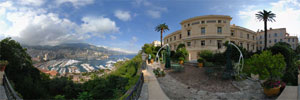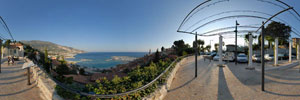Nice Panorama
- News :
- French Riviera :
- Provence :
- Var :
- Leisure :
- Economy :
- Gastronomy :
- Sport :
- Accommodation :
- Tourism :
- Site Map :
Monaco’s region on the French Riviera : a virtual visit
Monaco
is the second smallest independent state in the world after the Vatican. The principality paradoxically offers tourists many entertainments.
The visit of the old town on the Rock (rocky promontory extending into the Mediterranean,) allows to discover the Prince’s Palace, the Cathedral and the Oceanographic Museum with its famous aquarium. It is also the site of Monegasque institutions (Town Hall, Government, National Council (parliament of Monaco)).
The district of Monte Carlo is famous for its Casino, Hotel de Paris, the Opera and Ballet. That of Fontvieille houses the Stadium Louis-II where plays the AS Monaco football club. The stadium also hosts athletics meetings and the final of the European Super Cup.
The principality also serves as a framework for various sporting events which include the Monaco Formula 1 Grand Prix (world championship of Formula 1), the Rally Automobile Monte-Carlo and the Monte-Carlo Masters of the Monte Carlo Country Club.
Botanical Gardens lovers can visit the exotic garden of Monaco particularly in May when the cactuses are in bloom. Each winter, the city welcomes the International Circus Festival of Monaco.
Heritage Days are an excellent opportunity to discover the main attractions, including the grand apartments of the Prince’s Palace, the residence of Minister of State, the National Council. The Oceanographic Museum provides, at this occasion, a right of admission at reduced prices.
Menton
has a history associated with lemon since the 15th century. From a medieval culture (cereals, vines and fig trees), the inhabitants of Menton intensified the cultivation of olive trees (the first oil mills appear in the 14th century). The first citrus trees appear in the 15th taking advantage of the microclimate of Menton.
Menton is for five centuries (14th to 19th) under the suzerainty of the Princes of Monaco. In 1848, Menton seceded from the principality of Monaco with its neighbor Roquebrune because the Prince Florestan I of Monaco maintained a tax on the export of lemons, the main resource of these cities. Incorporated in free cities, they are administered by the house of Savoy until 1861 when they became French. Napoleon III paid a compensation of four million francs for the two cities to Prince Charles III of Monaco.
Today, the lemon is one of the symbols of the city of Menton. The Lemon Festival is hold in the city since over seventy years. It takes place between the last three weekends in February.
In July, the festival "Menton, my town is tango" is an opportunity to dance argentinian tango on the seafront with the regulars of the region but also many italian tourists. The festival organizes, for this occasion, some concerts, performances and dance workshops.
Menton contain many interesting monuments to visit. The Carnolès Palace, which is the former home of Antonio I of Monaco, and hosts the largest collection of citrus in France. The Bastion, which was built on the open sea in the 17th as a forward defence of the port, is today in the port of Menton and houses the Jean Cocteau Museum. The Town Hall with the wall paintings of the marriage hall by Jean Cocteau. The Basilica of Saint-Michel in Baroque style.
Thanks to its microclimate, Menton hosts exceptional gardens (Biovès Gardens, Botanical Garden Val Rahmeh, Fontana Rosa, Pian Park, La Serre de la Madone, Villa Maria Serena).
Around Monaco
Around Nice
Around Cannes
Around Grasse

